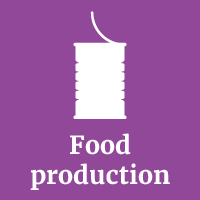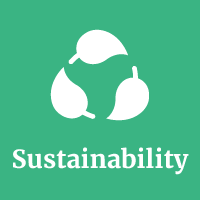
The Food Production Microbiome - Quiz
Microbiomes (communities of microbes that live together in a specific environment) are present everywhere in the food system, and they can be found all along the food chain. They play an important role when it comes to the cultivation, manufacturing and preservation of foods. How? Learn it by testing your knowledge with this quiz!
Food Production Quiz
Question 1 |
When we want to produce food - what could be the benefits of exploring the microbiome?
A | It can reduce the use of pesticides and fertilizers |
B | Animals have to take fewer antibiotics |
C | Both |
Question 1 Explanation:
Regarding meat production, we can help animals be healthier via microbial applications (e.g. stimulating positive microbes via the feed they eat). Soil microbiome manipulation can potentially reduce the use of pesticides by improving the ability of soils to resist or recover from pathogen infestation.
Question 2 |
Which percentage of our food is related to soil and, therefore, also to soil microbiomes?
A | 30% |
B | 95% |
C | 70% |
Question 2 Explanation:
Over 95% of our food, including fruits, vegetables, grains, meat, and dairy, is directly or indirectly reliant on soil (FAOSTATs 2022). and microbiomes play a crucial role in maintaining the ecosystem balance.
Question 3 |
An unbalanced microbiome in the animal gut could affect the quality of the meat, true or false?
A | Yes, it’s true |
B | False |
C | Only partially true |
Question 3 Explanation:
The quality of meat is significantly influenced by the health of the animal. In pigs, for instance, the gastrointestinal tract functions as a complex ecosystem in which the balance between different microbial communities plays a crucial role in determining the overall health of the animal. This balance has a profound impact on the quality of the meat produced.
Question 4 |
Why is a balanced community of microbiomes in our food important?
A | Because it means safer food |
B | Because it prevents food spoilage |
C | Because it decreases the amount of sugar in food |
Question 4 Explanation:
Balanced microbiomes increase the resistance to human diseases, prevent zoonosis (diseases that spread from animals to humans, such as Salmonella or Ebola virus), and help pathogen control, all contributing to greater food safety.
Question 5 |
What is one of the potentials or risks of using microbiomes in farming practices?
A | Could be dangerous for soil productivity in the long term |
B | It helps reduce the environmental footprint of agriculture |
C | Both |
Question 5 Explanation:
The use of microbiomes in agriculture can enable us to reduce our environmental footprint. How? For example, by replacing chemical, environmentally harmful fertilisers through microorganisms that are directly applied on the field to promote plant growth, stress resilience and the health of crops. You could think of it as ‘probiotics for the soil’.
Question 6 |
How do balanced microbial communities in our soil affect our food production?
A | They provoke a decrease in soil productivity but a healthier product |
B | They provoke an increase in soil productivity and a healthier product |
C | Microbiomes have no influence on the food production chain |
Question 6 Explanation:
A well-balanced ecosystem is incredibly important in terms of productivity and health for the food system! On the contrary, when an individual microbial species of a community of species have the opportunity to outcompete other community members because of changing environmental conditions, the diversity of the ecosystem will decrease. A lower diversity can compromise the health of plants, animals and human beings.
Question 7 |
The microbiome is an essential part of the marine ecosystem and also impacts the fish we eat. Which answer is not true?
A | In natural environments, fish are exposed to microbes that help them build strong immune systems |
B | In artificial environments, we sometimes have to support the fish, for example, with probiotics, to ensure their welfare |
C | The microbiome of fish in nature and in artificial environments is the same, as long as they eat the same feed |
Question 7 Explanation:
The microbiome is an essential part of the complex marine ecosystem, playing a crucial role in the health and survival of marine organisms, as well as the sustainability of aquaculture practices. Fish living in natural environments are exposed to microbes that help them to train their immune system. In artificial environments, precautionary measures are used to reduce the risks of infections, whereby the number of bad bacteria the fish are exposed to is reduced, but also the number of good bacteria. Therefore, many fisheries feed their fish with probiotics to support the animal’s immune system.
Question 8 |
What’s probably the best way to study the potential of microbiomes for food production?
A | Researchers focus on analysing the food itself |
B | Researchers observe all aspects of the food production |
C | No need to study - we already understand the potential very well; we just have to use the applications more |
Question 8 Explanation:
An effective way to study the potential of microbiomes for better food production involves studying all parameters of a production process. This is because microbiomes are connected across ecosystems, meaning that changing parameters within one microbiome will have consequences for microbiomes in other environments In the CIRCLES project, for example, researchers first observe a diversity of parameters (e.g., the microbiome of tomato plants, of pigs, of fish, etc.). Then, they intervene (e.g. adapting the soil where tomatoes are grown, or changing the feed given to pigs and fish) and observe again to understand the impact of the intervention.
There are 8 questions to complete.
You have completed
questions
question
Your score is
Correct
Wrong
Partial-Credit
You have not finished your quiz. If you leave this page, your progress will be lost.
Correct Answer
You Selected
Not Attempted
Final Score on Quiz
Attempted Questions Correct
Attempted Questions Wrong
Questions Not Attempted
Total Questions on Quiz
Question Details
Results
Date
Score
Hint
Time allowed
minutes
seconds
Time used
Answer Choice(s) Selected
Question Text
All done
Need more practice!
Keep trying!
Not bad!
Good work!
Perfect!



